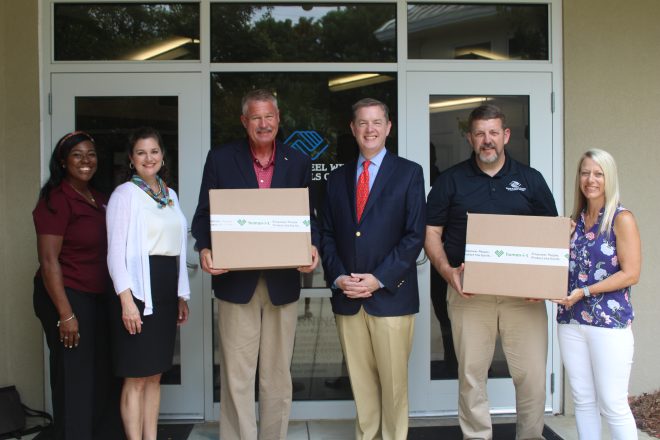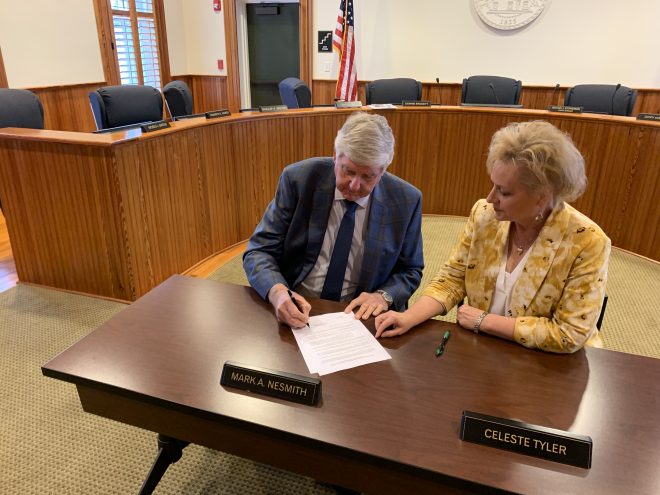Inside the game
Published 9:55 am Friday, December 9, 2005
THOMASVILLE — It was nice that Mother Nature and the vagaries of the Thomas University baseball schedule took a bit of a pause after last week’s thrilling 12-inning game with Georgia College and State University.
Though Mike Lee’s Night Hawks were beaten 7-5 in extra innings, Lee proclaimed it “the game of the year.”
Since Georgia College and State University was ranked as the No. 2 Division II team in the country at the beginning of last week, Lee was enthusiastic about the way his team performed vs. such credible opposition.
And for one particular inning, where TU pitcher Danny Caron allowed GCSU to load the bases, then brilliantly worked out of the jam without allowing a run — TU led 2-0 at the time — Lee gave us a window into the inside workings of a collegiate baseball game.
“There’s a lot there that people don’t really see,” Lee said. “A lot of times, they’ll see a guy thrown out stealing or swing at a bad pitch and be all over the guy. What they may not know is, we may have a play on.”
Similarly, they may not understand the inner workings of the game itself; how a pitcher works, what kinds of pitches he throws and why and the intricate process of setting up a batter.
Since Thomas University had jumped out to a 2-0 lead, Lee was trying to call pitches cleverly as the GCSU lineup came up for the second time against Caron.
Leading off the fourth inning was GCSU’s cleanup hitter, Jose Leger.
“I’d been starting everybody off with a slider or a curveball, something off speed,” Lee said. “So I thought it was time to come in with a first-pitch fastball.”
He called it, Caron threw it and the ball was scorched to centerfield for a base hit.
“Sometimes, a hitter guesses right,” Lee laughed. “But anyway, with the leadoff guy on, now Danny had to go to work.”
The next hitter was left fielder Matt Nixon, a batter that Caron had had some success with in his first trip to the plate.
“We threw him breaking balls the first time up and got him to ground out, reaching for a slider,” Lee said. “So that was our idea here: make him hit that pitch again.”
Though it appeared Nixon guessed what Caron was going to do, the pitches were too good for him to handle. He fell behind in the count, 1 ball, two strikes.
“Now what we wanted was a ground ball,” Lee said. “But he’d seen two sliders in a row and we didn’t want to come back with another. So Caron threw a changeup, a good one and Nixon hit it off the fist.”
The weak popup was caught and there was one out.
Next up was left-handed hitting first baseman Tyler Folsom and it provided an interesting test for Lee’s standard philosophy for a right-handed pitcher facing a left-handed hitter.
“Normally, we go away (pitch outside) vs. a lefty,” he said. “Sometimes, we’ll show him something inside. But anyway, his first time up, we walked him on four pitches. So we knew that this time, we’d try to go inside on him.”
But first, Caron had to set him up.
“We opened up with a changeup away, which he took for Strike One,” he said.
“Then we threw a fastball for Strike Two and he swung at it weakly and didn’t look good at all.”
So you could guess what was coming next, right?
Sure enough, the next pitch was the standard “pitcher’s pitch.”
“What we try to do is get the pitcher to throw one, say one inch off the black around home plate,” Lee explained. “Either that, or we’ll throw something to set up the next pitch.”
So Caron wound and fired that inside fastball that they stayed away from in his first at bat.
“He took it, but it just missed,” Lee said. And now, it was time to finish him.
“We went back away with the slider, a breaking pitch that we were pretty sure he wouldn’t be able to do much with because he hadn’t seen it yet.
“A lot of times, I’ll try to get through the order the first time around and not show him every pitch, so we can have a surprise when we need it.”
They were right.
Caron’s slider was nice and sharp and broke over the outside corner. Nixon chased it — and missed it — for Strike Three.
But with two outs and a man on first, the inning wasn’t over yet.
Next up was big strong John McDonald, who had a quick bat.
“His first time up,” Lee said, “we started him off with a first-pitch fastball and he hit a laser to centerfield. We caught it for an out, but it was really hit.
“So we knew that he was aggressive and decided to stay away (pitch outside) from him as much as possible and stay away from another fastball.”
Caron went to the slider and threw three of them in a row. Two of them missed so he fell behind in the count, two balls, one strike.
“Now what we don’t like to do is give in,” Lee said. “We don’t like to throw that 2-1, 2-0 fastball, a pitch that the hitter can sit on and rip.”
So, what Lee will do is try to catch the hitter looking for that straight fastball on that pitch.
“We’ll throw a straight change,” he said, “or maybe a changeup curveball, trying to get him to jump at it.”
It was great — in theory. And sure enough, McDonald was fooled by the pitch and lunged for the ball.
Problem was, he caught it on the end of the bat and drove it in a hole between short and third.
Why was there a bigger hole than usual there? Strategy.
“We’d read the scouting report on those guys coming in,” Lee said. “And they’d stolen 60 bases coming into our series.
“So we pinched our fielders in a bit, hoping we’d get better coverage at second base. That left some holes and that ball found one of them.”
See how intricate baseball can be?
The predicament changed now for Caron. Instead of a relatively harmless two out, man on first situation, the GCSU ballclub was one swing away from a lead.
But Lee was confident that Caron, who pitched last season for Central Florida Community College, had the poise to get out of a jam.
“Danny is one of our better pitchers for holding runners on,” Lee said. “And I felt as though Danny was well aware of the situation and what he needed to do.
“He just needed to make one pitch. That’s all.”
The next hitter for GSCU, designated hitter Chris Aeschlimann, had bounced into a force out earlier in the game. And Caron and Lee were confident that they could get him to do it again.
Since Caron’s slider had been breaking well, they stayed with that pitch and threw it for the first two pitches of the at-bat. Both missed.
Again, down in the count, two balls, no strikes, Caron stayed away from the “book” pitch — a fastball.
“We went with changeup away and he fouled it off,” Lee said. So then, the coach figured, he was ripe to come inside. He called fastball in.
Caron threw it, Aeschlimann swung and was indeed fooled. But he got enough of the ball on his fists to bloop it in the hole, loading the bases.
Caron took a deep breath and so did Lee. The No. 9 hitter, J.J. Jones was up next and he certainly didn’t look like a 9-hole hitter. Strong, with a quick bat, he’d hit a hard shot up the middle on the first pitch in his first at-bat and was barely thrown out.
“So, in this situation, we assume he’s going to be aggressive so we want to stay away from something straight.”
After two sliders (one was fouled), Lee tried to fool him with a changeup and did. Strike two. But two more sliders missed and the count grew full. It was decision time.
“We knew he’d be setting fastball and we weren’t sure we could get the change over.”
He tried a slider. And Caron threw it low, out of the strike zone. Jones couldn’t hold back. He chased it — and missed. The strategy worked.
As it turned out, Caron wasn’t able to finish the game. Reliever Josh Clements came in and pitched fairly well, finally weakening in the 12th.
But the Night Hawks, as Lee said, are indeed starting to get the hang of how to play this game. Pitch by pitch.
“They’re starting to think the game,” Lee said. “That’s a very positive sign.”





